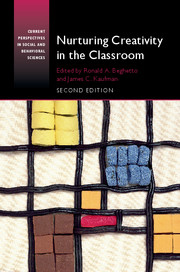Book contents
- Frontmatter
- Dedication
- Contents
- Preface
- Acknowledgments
- PART I VOICES FROM THE FIELD
- PART II VOICES FROM THE RESEARCH
- 5 Developing Creativity Across All Areas of the Curriculum
- 6 Accountability, the Common Core, and Creativity
- 7 Ever-Broadening Conceptions of Creativity in the Classroom
- 8 Creativity in Mathematics Teaching: A Chinese Perspective (An Update)
- 9 Roads Not Taken, New Roads to Take: Looking for Creativity in the Classroom
- 10 The Five Core Attitudes and Seven I's of the Creative Process
- 11 Creativity Embedded into K–12 Teacher Preparation and Beyond
- 12 Attitude Change as the Precursor to Creativity Enhancement
- 13 Nurturing Creativity in the Engineering Classroom
- 14 Intrinsic Motivation and Creativity in the Classroom: Have We Come Full Circle?
- 15 Learning for Creativity
- 16 Creativity and Prosocial Values: Nurturing Cooperation within the Classroom
- 17 How Social-Emotional Imagination Facilitates Deep Learning and Creativity in the Classroom
- 18 Four Faces of Creativity at School
- 19 Teaching for Creativity
- 20 A Coda for Creativity in the Classroom: Take-Home Points and Final Insights
- Index
- References
5 - Developing Creativity Across All Areas of the Curriculum
from PART II - VOICES FROM THE RESEARCH
Published online by Cambridge University Press: 24 November 2016
- Frontmatter
- Dedication
- Contents
- Preface
- Acknowledgments
- PART I VOICES FROM THE FIELD
- PART II VOICES FROM THE RESEARCH
- 5 Developing Creativity Across All Areas of the Curriculum
- 6 Accountability, the Common Core, and Creativity
- 7 Ever-Broadening Conceptions of Creativity in the Classroom
- 8 Creativity in Mathematics Teaching: A Chinese Perspective (An Update)
- 9 Roads Not Taken, New Roads to Take: Looking for Creativity in the Classroom
- 10 The Five Core Attitudes and Seven I's of the Creative Process
- 11 Creativity Embedded into K–12 Teacher Preparation and Beyond
- 12 Attitude Change as the Precursor to Creativity Enhancement
- 13 Nurturing Creativity in the Engineering Classroom
- 14 Intrinsic Motivation and Creativity in the Classroom: Have We Come Full Circle?
- 15 Learning for Creativity
- 16 Creativity and Prosocial Values: Nurturing Cooperation within the Classroom
- 17 How Social-Emotional Imagination Facilitates Deep Learning and Creativity in the Classroom
- 18 Four Faces of Creativity at School
- 19 Teaching for Creativity
- 20 A Coda for Creativity in the Classroom: Take-Home Points and Final Insights
- Index
- References
Summary
Imagination grows by exercise.
W. Somerset MaughamThis chapter will deal with two aspects of providing teachers with guidance about encouraging more creative thinking in their classrooms. The first part will focus on a few basic principles and strategies underlying creativity training and how these principles and strategies can lead us in the more practical task of developing creativity- training exercises. This section uses a “learn-by-doing” approach and will prepare you for the more advanced challenge of developing your own activities.
The second part of the chapter focuses on using the basic principles of creative thinking to develop your own activities. In this section you will be asked to examine any and all topics that are part of the regular curriculum or prescribed curricular standards and to design and infuse creative thinking activities into standards based curricular topics. This section is purposefully designed to develop your own creativity, and by so doing you will not only be enriching the regular curriculum for your students but also modeling the creative process for them.
PART 1: BASIC PRINCIPLES AND START-UP ACTIVITIES
Three Major Starting Points. Although a great deal has been written about fostering creativity in classrooms, relatively few basic teaching strategies have been effective in encouraging creative development. The starting point for teachers who would like to promote more creative behaviors in their students is a basic understanding of the difference between convergent and divergent production. In most traditional teaching-learning situations, major emphasis is placed on locating or converging on correct answers. Teachers raise questions and present problems with a predetermined response in mind, and students’ performance is usually evaluated in terms of the correctness of a particular answer and the speed and accuracy with which youngsters respond to verbal or written exercises. Thus, the types of problems raised by the teacher or textbook and the system of rewards used to evaluate student progress cause most youngsters to develop a mindset that is oriented toward zeroing in on the “right” answer as quickly and efficiently as possible. Although this ability has its place in the overall development of the learner, most teachers would agree that impressionable young minds also need opportunities to develop their rare and precious creative thinking abilities.
- Type
- Chapter
- Information
- Nurturing Creativity in the Classroom , pp. 23 - 44Publisher: Cambridge University PressPrint publication year: 2016
References
- 8
- Cited by

